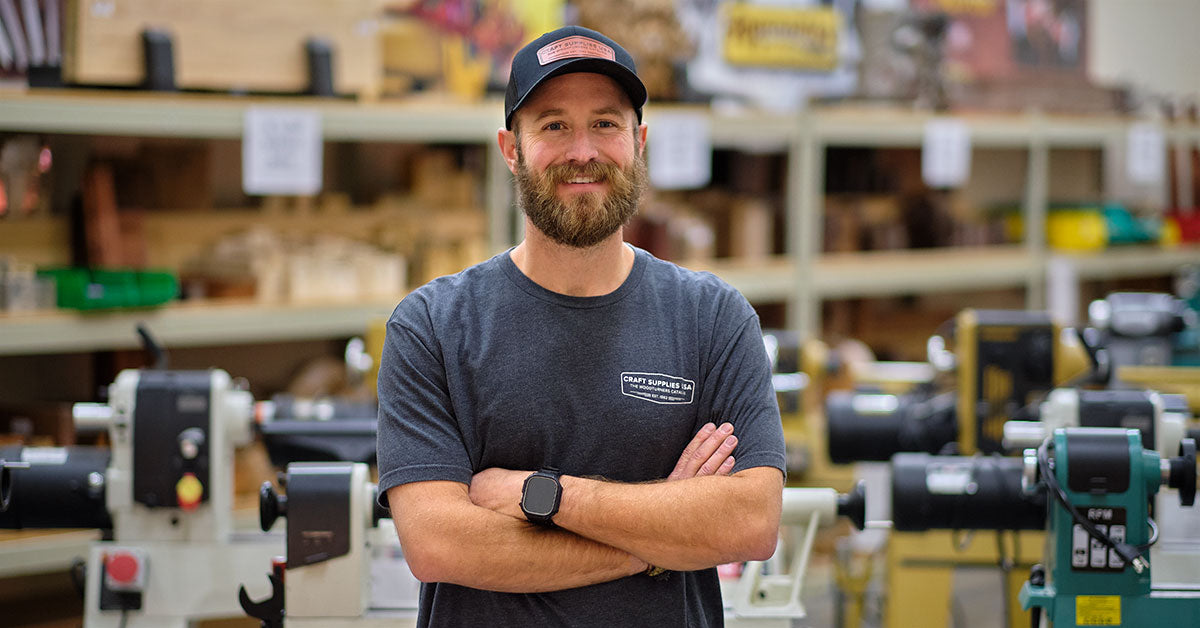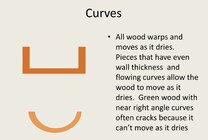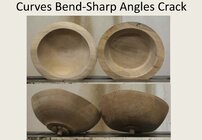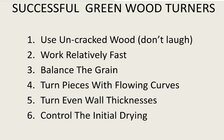So much trouble with wood cracking and the time it takes to dry, I give up. I'd like to start turning epoxy resin projects so I need advice as to how/where to start. Should I buy both vacuum pot and pressure pot? Which resin do I use or does it matter? Cost of course is consideration. PLEASE HELP I spent big $$ for a good lathe 14in dia capacity with a 1hp motor. Thanks so much in advance!!
-
December 2025 Turning Challenge: Single Tree! (click here for details) -
Congratulations to Bob Henrickson, People's Choice in the November 2025 Turning Challenge (click here for details) -
Congratulations to John Dillon for "Chinquapin Oak" being selected as Turning of the Week for December 22, 2025 (click here for details) -
Welcome new registering member. Your username must be your real First and Last name (for example: John Doe). "Screen names" and "handles" are not allowed and your registration will be deleted if you don't use your real name. Also, do not use all caps nor all lower case.
You are using an out of date browser. It may not display this or other websites correctly.
You should upgrade or use an alternative browser.
You should upgrade or use an alternative browser.
HELP HELP HELP!!!! how to start using epoxy resin
- Thread starter Joe Div
- Start date

Casting & Stabilizing
Many of the most beautifully figured woods are also nearly unworkable because of spalting and decay or they may be inherently unstable. Wood fortifiers and stabilizers go a long way to solving the problem by making these woods workable by simply soaking them in a solution and letting them dry...

Stabilizing Wood Blanks at Home
Video – Stabilizing Wood Blanks at Home A lot of wood blanks are too soft or spalted to turn without blowing apart. Luckily there is a solution! Stabilizing is a process that uses pressure to force a resin deep into the cells of a blank, then uses heat to cure the resin. The result is a...
I don't know how to personally do it, it is not my area of expertise, but these two links may be helpful.
Take a step back and think about what sort of turning projects you really want to do. Do you want to turn wood or plastic composites? Working with wood has a learning curve, especially in regard to using and drying green wood. There is a lot of information available on this forum and elsewhere on this subject because it is a (not insurmountable) challenge for every woodturner using wet wood, meaning most of us. If you want to make objects more than about 4" in diameter without laminating or segmenting timber you need to understand how to dry pieces without problems- it is done all the time and it is not rocket surgery. Plastic resins do not repeal the fundamentals of wood movement.
I mostly work with wet timber directly from the forests around me. Probably half of the time I turn once from green to finish. Doing this successfully requires turning thin, even thickness walls, either quickly or by keeping the work wet between sessions and slowing down the initial drying. When I twice turn pieces I rough them out with even walls thick enough to allow for warpage after drying. I usually seal the end grain and put the roughouts in paper bags or cardboard boxes to slowly dry out in a moderate temperature and humidity without much air movement. I am not in a hurry, but those who are use various types of kilns to speed up the process using the same principle of controlled drying.
I always seal the ends of logs and turning blanks as soon as I crosscut them to prevent the start of checking. Blanks should be turned soon after blocking out to minimize problems Once checks are started they are likely to propagate so I try to stay ahead of the curve. I keep my wet stock outside in the shade under a tarp or in a woodshed.
If you are serious about epoxy resin projects you need to start with dry wood. Epoxy and wet wood will inevitably part ways.
I mostly work with wet timber directly from the forests around me. Probably half of the time I turn once from green to finish. Doing this successfully requires turning thin, even thickness walls, either quickly or by keeping the work wet between sessions and slowing down the initial drying. When I twice turn pieces I rough them out with even walls thick enough to allow for warpage after drying. I usually seal the end grain and put the roughouts in paper bags or cardboard boxes to slowly dry out in a moderate temperature and humidity without much air movement. I am not in a hurry, but those who are use various types of kilns to speed up the process using the same principle of controlled drying.
I always seal the ends of logs and turning blanks as soon as I crosscut them to prevent the start of checking. Blanks should be turned soon after blocking out to minimize problems Once checks are started they are likely to propagate so I try to stay ahead of the curve. I keep my wet stock outside in the shade under a tarp or in a woodshed.
If you are serious about epoxy resin projects you need to start with dry wood. Epoxy and wet wood will inevitably part ways.
I did seal the end of some logs ( cut in half first) but how long to wait, I don't know! I've had some turnings not crack and others crack?????? I'm wondering if eliminating the pith cures the cracking issues??? SO confused and I've been reading and reseraching, I don't want to get frustrated. I've watched so many utube videos and still am not sure which path to take!!! I di buy a vacuum pot and I'm thinking a pressur pot may also be needed? Sorry for being such a ditz , I really really need help/advice.
Get hold of a copy of Bruce Hoadley's Understanding Wood. That will help you to understand the fundamentals. Here's one thread on drying blanks and bowls that might help- there are many others. https://www.aawforum.org/community/threads/drying-wood.19302/I did seal the end of some logs ( cut in half first) but how long to wait, I don't know! I've had some turnings not crack and others crack?????? I'm wondering if eliminating the pith cures the cracking issues??? SO confused and I've been reading and reseraching, I don't want to get frustrated. I've watched so many utube videos and still am not sure which path to take!!! I di buy a vacuum pot and I'm thinking a pressur pot may also be needed? Sorry for being such a ditz , I really really need help/advice.
Retaining the pith will almost always ensure cracks, but eliminating it is just part of avoiding them. Don't wait to turn blanks after blocking them out, get on it right away and take whatever measures you choose to slow down moisture loss after that. Some people boil bowls, sozzle them in denatured alcohol and microwave them, but start with the basics and learn by experience what works in your environment with your timber.
will do,thanks so much and please feel fee to add any advice or other info
Building on what Kevin said, what size of project do you want to turn? For small projects like pen blanks I use Alumilite resin (sold at Walmart, Michael's and Hobby Lobby) but for large or deeper pieces I use a different type of resin, one that pours better and is easier to get the bubbles out like marine resin. Also, you'll need tools to work with resin such as molds, pigment and possibly carbide chisels. Plan out what you want to turn first, it will help you figure what tools you need.Take a step back and think about what sort of turning projects you really want to do. Do you want to turn wood or plastic composites? Working with wood has a learning curve, especially in regard to using and drying green wood. There is a lot of information available on this forum and elsewhere on this subject because it is a (not insurmountable) challenge for every woodturner using wet wood, meaning most of us. If you want to make objects more than about 4" in diameter without laminating or segmenting timber you need to understand how to dry pieces without problems- it is done all the time and it is not rocket surgery. Plastic resins do not repeal the fundamentals of wood movement.
I mostly work with wet timber directly from the forests around me. Probably half of the time I turn once from green to finish. Doing this successfully requires turning thin, even thickness walls, either quickly or by keeping the work wet between sessions and slowing down the initial drying. When I twice turn pieces I rough them out with even walls thick enough to allow for warpage after drying. I usually seal the end grain and put the roughouts in paper bags or cardboard boxes to slowly dry out in a moderate temperature and humidity without much air movement. I am not in a hurry, but those who are use various types of kilns to speed up the process using the same principle of controlled drying.
I always seal the ends of logs and turning blanks as soon as I crosscut them to prevent the start of checking. Blanks should be turned soon after blocking out to minimize problems Once checks are started they are likely to propagate so I try to stay ahead of the curve. I keep my wet stock outside in the shade under a tarp or in a woodshed.
If you are serious about epoxy resin projects you need to start with dry wood. Epoxy and wet wood will inevitably part ways.
Alternately, why are your blanks cracking? Do you have a mentor or woodturning club you can ask? I'm not sure where you are in NH but if you want a club you can use the search tool on the AAW site: https://www.woodturner.org/Woodturner/AAWConnects/AAW-Connects.aspx
Also, have you thought about posting pictures of your work? There's lots of people here who could help you. Also, where are you getting your blanks from. are you buying them or preparing them yourself? Your problems could be from the wood blanks you're using.
Before you spend more money maybe post some pictures and ask some questions or visit a club.
- Joined
- Apr 27, 2004
- Messages
- 9,307
- Likes
- 6,080
- Location
- Lakeland, Florida
- Website
- www.hockenberywoodturning.com
don't know! I've had some turnings not crack and others crack?????? I'm wondering if eliminating the pith cures the cracking issues?
If you want to turn bowls there are 2 basic ways to proceed.
1. Turn a bowl with a wall thickness of about 10% diameter. Dry this bowl for a year or so after sealing with anchor seal. Or dry it in paper bags for 8 - 9 months. Then return the warped bowl round.
2. Turn a bowl with a relatively thin wall. 3/16 inch or so. Dry it in paper bags for a few days. Sand and finish it.
Shape is a big factor in successful drying. Many new turners start out like I did with a classic dog dish shape. Straight sides flat bottom. These almost always crack
The slide on the right 2 oak bowls the bowl shown on the right cracked flat bottom keeps the wood from moving as it dries.
 .
. 
My first attempt to show a flat bottom bowl cracking I used soft maple - the darned thing didn’t crack.- maple just too forgiving.
Tips for successful green wood turning

These slides give an overview of working with green wood.
Last edited:
